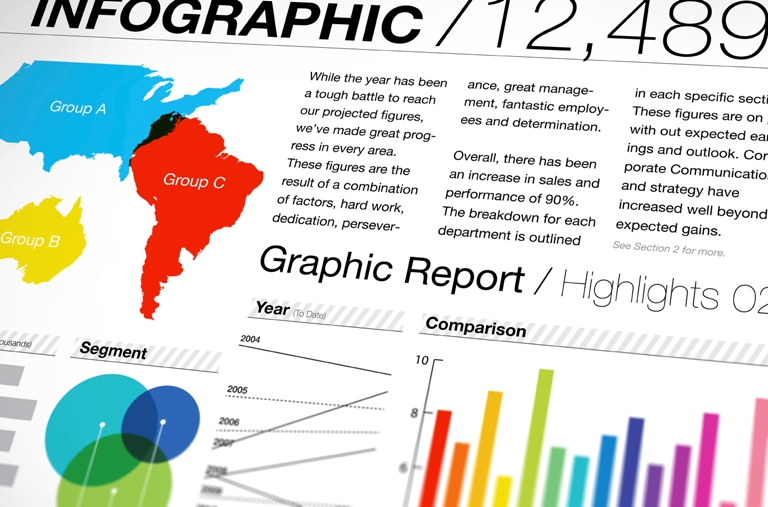 In a previous article, we demonstrated how the integration of infographics into your digital content marketing campaign can bring wonderful results for your business, particularly in terms of raising the profile of your brand and improving the SEO ranking of your site. Arguably the most popular use of an infographic is to visualise data, whether it be the results of a survey or statistics of consumerism – infographics can be used to communicate a wide range of information succinctly. One example of an excellent data visualisation infographic that went super-viral is the Death and Taxes infographic by Timeplots. This infographic carefully elucidated America’s 2014 Federal Budget in a way that was immediately comprehensible and visually compelling, hence why it became so popular online. While visualising data is certainly a timeless theme for infographics, there are many alternative approaches which can yield the same high level of sharability. Here are four approaches you may care to consider:
In a previous article, we demonstrated how the integration of infographics into your digital content marketing campaign can bring wonderful results for your business, particularly in terms of raising the profile of your brand and improving the SEO ranking of your site. Arguably the most popular use of an infographic is to visualise data, whether it be the results of a survey or statistics of consumerism – infographics can be used to communicate a wide range of information succinctly. One example of an excellent data visualisation infographic that went super-viral is the Death and Taxes infographic by Timeplots. This infographic carefully elucidated America’s 2014 Federal Budget in a way that was immediately comprehensible and visually compelling, hence why it became so popular online. While visualising data is certainly a timeless theme for infographics, there are many alternative approaches which can yield the same high level of sharability. Here are four approaches you may care to consider:
1) Tell a story
Example: The Life and Times of Steve Jobs by Infographic World
It isn’t easy to weave a list of facts and USPs into a coherent narrative which keeps the reader’s eyes glued to the page all the way to the conclusive call to action – ask any copywriter! Fortunately with an infographic, you can use impactful illustrations to keep your readers locked in all the way to the punch line, whatever that may be. People process visual information faster than text, so from a psychological perspective it makes sense to integrate both mediums together. In the age of information, people’s attention spans are much shorter than ever before, which leads us to scan information rather than read it sequentially. With this in mind, scanning your way through an artistic portrayal of Steve Job’s life with all the key facts included in bite size chunks is far more appealing to the average internet user than reading his Wikipedia page.
2) Explaining the capabilities of your business
Example: Industrial Decoration by Xennia Technology
This is a particularly useful approach for technology companies which are looking to commission an infographic. While white papers and blog posts are an excellent way of explaining the nuts and bolts of a technology and how it can benefit the customer – we all know that customers are influenced by emotions more than logic. In the above example, Xennia demonstrate excellently the different applications of inkjet technology in a way that is immediately relatable. Presenting information in such a way allows customers to understand the tangible benefits of a technology (how a person’s house can be decorated), without having to invest their time and energy into researching the technical details which are not of immediate relevance.
3) Make a witty juxtaposition
Example: Geek vs. Nerd by Killer Infographics
When it comes to the world of , the ability to answer a much-debated question with a sprinkling of light humour is certainly a winning strategy. The Geek vs. Nerd infographic is excellent, not only because it visually depicts the differences between both personality archetypes in a visceral (and hilarious) manner, but also because it is highly relatable. For someone who is undergoing an identity crisis as to whether they are in fact a geek or a nerd, a self-analysis based on the criteria of this infographic will surely provide the answer – unless they work as a rocket scientist but also have a penchant for ironic t-shirts, of course.
4) Visualise a theory
Example: How Will Life End? By Mammoth Infographics
Without a visual aid, explaining a hypothetical theory can be a tricky business. While one can read an essay, white paper or blog pertaining to a specific theory, without any visual stimulation we are left to our own imagination to ponder over how the theory would actually look if it were to become objective reality. While some marketing aficionados would argue otherwise, an infographic doesn’t have to be laden with stylistic bar charts and statistics printed in impactful font – sometimes an infographic is great because of its visceral impact. Perhaps thanks to apocalyptic movies such as 2012 and War of the Worlds, there seems to be an ever-expanding list of theories for the way that life on earth will eventually come to an end. With the infographic above, a list of the most poignant theories (and a couple of humorous ones) for human extinction has been weaved together into a powerful graphical montage, allowing the reader to visually compare each potential fate for mankind!
Tags: infographic, infographics, PR, promotion



